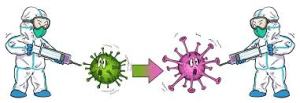You are currently browsing the tag archive for the ‘mutation’ tag.
Is COVID-19 Mutating? Yes – But Not Harmfully!
By Shlomo Maital
I’ve been worrying about whether the SARS-CoV-2 virus (the piece of RNA that gives people COVID-19) is mutating. Evolution is everywhere and inexorable, and it creates animals, insects and even viruses that are well adapted to survive and meet threats. So, I wondered, is the novel coronavirus mutating, to defeat our best efforts?
The answer is no. Here are answers from Dr. Edward Holmes, an evolutionary virologist at University of Sydney, in today’s New York Times.* I present his findings as Q&A:
- “The coronavirus is mutating, and that’s fine (so far).” NYT Sept. 14, p. 11.
Do viruses really mutate?
“Viruses routinely mutate — and most of these changes are bad for the virus or even fatal, according to some studies. (A minority of mutations are neutral, and only a tiny minority beneficial.) The word “mutation” may sound ominous, but it is a humdrum fact of viral life and its implications most often aren’t nefarious for humans.”
Has COVID-19 become more virulent, more dangerous?
“ The real question is this: Has it become more virulent or more infectious than it was when it was first detected in Wuhan, central China, in December? The evidence suggests that it has not. Like the viruses that give us influenza or measles, SARS-CoV-2 has a genetic code made up of RNA, or ribonucleic acid. But RNA is highly mutable, and since SARS-CoV-2 infects us by using our body’s cells to replicate itself again and again, every time its genome is copied, an error might creep in. Most mutations are quickly lost, either by chance or because they damage some part of the virus’s main functions. Only a small proportion end up spreading widely or lasting. Mutation may be the fuel of evolution but, especially for an RNA virus, it also is just business as usual.”
How fast is COVID-19 mutating?
“RNA viruses tend to evolve rapidly — about a million times faster than human genes. Yet if SARS-CoV-2 stands out among them, it is for evolving more slowly than many: about five times less rapidly than the influenza viruses, for example. According to Nextstrain, an open-source project that tracks the evolution of pathogens in real time, and other sources, SARS-CoV-2 is accumulating an average of about two mutations per month — which means that the forms of the virus circulating today are only about 15 mutations or so different from the first version traced to the outbreak in Wuhan. To my knowledge, there is to date no evidence that SARS-CoV-2 has become more virulent or more lethal — nor, for that matter, that it has become less so.”
Even if COVID-19 has not mutated to a more dangerous form, that kills more people – has it perhaps mutated to become more infectious – in a way Nature often does, to reproduce better? Is THIS perhaps why the coronavirus has created strong second waves in many countries?
“I do not believe that the evolution of SARS-CoV-2 is what’s driving the virus’s continued spread. The coronavirus remains good at propagating itself because most of us still are susceptible to it; we are not immune, and it can still find new hosts to infect relatively easily.”
Are you sure?
“There has been much discussion over whether the D614G mutation — which affects the so-called spike protein of the virus — has made SARS-CoV-2 more infectious. The spike protein sits on the surface of the coronavirus, and it matters because it’s the part of the virus that attaches to the host’s cells. “D614G” is shorthand for a change at position 614 of the spike protein, from an aspartic acid (D) to a glycine amino acid (G). (The technical literature refers to “D614” as the earlier configuration and “G614” as the later one.) The D614G mutation, which probably initially arose in China, first appeared to become more and more frequent in the outbreak in northern Italy in February. The G614 form of the virus has since spread all over the world and has become the dominant variant. The D614G mutation does seem to have increased the infectivity of the coronavirus — at least in cells grown in laboratories, according to a recent paper by the computational biologist Bette Korber and others published in the journal Cell.”
“Apparently based partly on this and other studies, health authorities in various countries have claimed that the G614 form of the coronavirus may be 10 times more infectious than the version first detected in Wuhan. But as some epidemiologists have warned, it is difficult, not to mention unwise, to extrapolate from lab results to explain how the virus actually spreads in a real population. In the issue of Cell …. the viral epidemiologist Nathan Grubaugh and colleagues argued that the “increase in the frequency of G614 could be explained by chance and the epidemiology of the pandemic.”
Bottom line?
“For now, though, SARS-CoV-2 essentially is the same virus that emerged in December. Sure, it has mutated, but not, so far, in ways that should change how scientists think about how to tackle it — and not in ways that should worry you.”
Does the Novel Coronavirus Mutate?
By Shlomo Maital
Writing in today’s New York Times, Nathaniel Lash and Tala Schlossberg try to answer the key question, does the novel coronavirus mutate? If so, how and when?
Here is why it is important for us to know this. The pandemic crisis will end only when we have a vaccine, produced in billions of doses. The vaccine will work by stimulating the body to produce antibodies that neutralize the virus by binding to it in a very specific way. If the virus can mutate to defeat the vaccine, then the vaccine will not stop working. The key is the “spike protein” – the protein the virus makes that penetrates the cell walls and lets the virus invade (and kill) it. Those are the spikes you see in the graphic illustrations of corona. Vaccines can defeat the spike.
Here is what the authors of the article have found:
“Among the thousands of samples of the long strand of RNA that makes up the coronavirus, 11 mutations have become fairly common. But as far as we know, it’s the same virus infecting people all over the world, meaning that only one “strain” of the virus exists, said Peter Thielen, a molecular biologist with the Johns Hopkins Applied Physics Laboratory. Only one of those common mutations affects the “spike protein,” which enables the virus to infect cells in the throat and lungs. Efforts to produce antibodies that block the spike protein are central to many efforts to develop a vaccine. Since the spike protein has changed little so far, some scientists believe that’s a sign that it can’t alter itself very much and remain infectious.”
So – we have a small piece of good news. The measles vaccine, for instance, was developed in 1950. And it is still effective. Measles hasn’t mutated in a manner that neutralizes the vaccine. Evolution is powerful – but apparently it cannot surmount EVERY obstacle. So hopefully the same will apply to the COVID-19 vaccine – and we will bid this insidious deadly enemy good-bye, with an effective vaccine… until the next one.
Coronavirus Genes Tell the Story!
By Shlomo Maital
COVID-19 genome Horseshoe bat
A saying in the Jewish Talmud: Know where you’ve come from, know where you are going. Based on a New York Times article on the virus genome:
Where did the novel coronavirus come from in the first place?
From a Chinese horseshoe bat…but “researchers found the virus infecting humans now split off from the bat decades ago and gained some unique mutations”. (Maciej Boni, Penn State U, using sophisticated computer programs analyzing genetic structures).
How do viruses mutate?
Sometimes two different coronaviruses enter a single cell, and the resulting copy made by the cell’s DNA is a combination of the two..a new mutation.
How different are the various coronaviruses?
In January a team of Chinese and Australian researchers published the first genome of the new virus. (Kudos to them! They distributed it instantly and widely!). Since then researchers worldwide have sequenced the genes of 3,000 coronaviruses. Some are identical, some are distinctive mutations.
Implication: For many years we will need to track this virus, lest it mutate viciously and ‘successfully’.
Where can researchers find the data on the virus genomes?
Look up the online database GISAID. Evolution experts are analyzing how the virus evolves, in a project called Nextstrain, and constantly update the virus ‘family tree’.
What did genome researchers learn about the spread of coronavirus in the US?
Dr. Trevor Bedford, U. of Washington, and team found that it was not spreading in the US “in December”. President Trump poured scorn on those warning about the spreading virus, calling it a ‘hoax’. Had quarantines been imposed earlier, many of the deaths could have been prevented. “A virus identified in a patient in late February (in New York) had mutation shared by one identified in Washington (state) on Jan. 20”. The current New York pandemic, deadly, could have been stopped if the experts’ warnings had been heeded. But “climate denial” and “science expert denial” seem to go together in the US Administration.
How many novel coronavirus versions have been found so far?
Researchers at Mt. Sinai Hospital, New York City, have “identified seven separate lineages of viruses that entered New York and began circulating.” They believe that …”we will probably find more”.
Is there any good news in all this research?
Yes! One piece of knowledge that has not been widely reported. “Some viruses evolve so quickly that they require vaccines that can produce several different antibodies”. (This makes producing a good vaccine really hard!). “But that’s not the case for COVID-19. Like other coronaviruses it has a relatively slow mutation rate compared to some viruses, like influenza. ..its mutation rate reveals, things could be a whole lot worse”.





